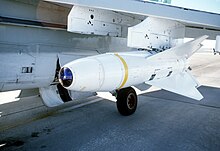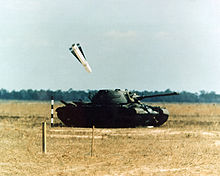Are There Cameras In A Missle While In Flight

The Walleye combined a dissimilarity seeker with a data link to the launch shipping that allowed manual override.
Optical contrast seekers, or simply dissimilarity seekers, are a type of missile guidance organization using a television camera as its chief input. The photographic camera is initially pointed at a target and so locked on, allowing the missile to fly to its target by keeping the image stable within the camera's field of view.
The kickoff production missile to use a contrast seeker was the AGM-65 Maverick, which began development in the 1960s and entered service in 1972. The organization has not been widely used, every bit other guidance technologies like laser guidance and GPS have become more common, but the same bones concept is used in cameras to track objects, including the systems used to aim the laser designators.
Dissimilarity seekers should be distinguished from television guidance systems, in which a live television signal is broadcast to the launch platform, which then uses manual direction to assault the target. Examples of Boob tube guidance include the Martel and AGM-62 Walleye. The term "contrast profile" is sometimes used, but this may be confused with TERCOM systems.
Basic concept [edit]
Analog television cameras scan an image as a series of horizontal lines that are stacked vertically to form a filigree or "frame". The camera'south progression through the frame is carefully controlled by electronic timers, known as time base generators, that produce smoothly increasing voltages. Equally the camera scans the image, the brightness of the location currently existence scanned is also represented as a voltage. The series of varying voltages from the sensor forms an amplitude modulated (AM) signal that encodes the brightness variations along any given scan line. Additional voltage spikes are added to the signal to signal when the line or frame ends.[i]
The dissimilarity seeker is a simple device that tin be implemented using bones analog electronics. It start uses some form of automatic gain control to accommodate the image brightness until information technology contains some areas with high-contrast spots. This produces a bias voltage signal to represent the background effulgence level, making brighter objects stand out. Any rapid modify in contrast forth a given scan line causes the voltage from the camera to suddenly modify. If the change is greater than a selected threshold, information technology triggers a second circuit that sends the output of the 2 scanning time base generators into capacitors. Thus, the capacitors store a voltage value representing the Y and X locations of whatever high dissimilarity spot within the image.[two]
The image from the missile's photographic camera is also sent into the cockpit where it appears on a small idiot box screen, oft one of the aircraft's multi-function displays. The missile is initially brought onto the target manually, commonly using a small-scale cueing input on the airplane pilot's command stick, or by the weapons officer in two-seat shipping. When the trigger is pressed to pickle the target, the contrast threshold circuits are turned on when the camera is scanning locations close to the pickled location on the screen. Any high-dissimilarity images inside that area will then exist memorized. Normally the recorded spot is indicated on the screen and the pilot tin can select other loftier-contrast spots inside the image, in an attempt to select ane that is either the target or very close to it.[2]
In one case a suitable target epitome has been selected, the seeker enters tracking mode. In this manner, the output from the camera is ignored except when it is scanning close to the original pickled location. In those locations the circuit triggers equally normal, sending the output to a 2d prepare of capacitors. By comparing the voltages in the two sets of capacitors, the deviation in location between the originally selected spot and the current spot is output equally an error point. This is sent into the seeker's gimbal mounting to plough the photographic camera and so information technology re-aligns with the original location. The guidance system and then compares the angle of the camera to the angle of the missile body, and sends commands to the aerodynamic controls to bring it back onto a collision course. To address the need to track moving targets, a proportional navigation system is normally used, which naturally produces the required lead.[2]
Problems [edit]
Contrast seekers are subject to issues when the contrast spot changes. This can occur quite easily if the target changes bending, causing the absolute brightness of the object to change, or if it moves, which tin change the contrast relative to the surround. For instance, a tank on a roadway might provide a very loftier contrast tracking spot, only to have that disappear when it drives off the road into depression bush. It can also be fooled by bogus lighting changes and similar effects. It is for this reason that the timers are gated, to limit the area in which the changes can take identify without breaking lock.
One solution to this trouble is to use infrared imaging instead of visible light. This is peculiarly well suited to LWIR cameras that image the heat signature of the target. This is very effective against vehicles like tanks, where the engine produces an excellent high-contrast image to seek on. Notwithstanding, this also greatly adds to the price of the seeker, especially in the 1970s when this technology was new, and also limits it to uses confronting vehicles or other hot sources. This means the aircraft has to carry two types of missiles, ones with IR for vehicles, and ones with visible lite seekers for attacking other targets like bridges or bunkers.
A more subtle problem is that the contrast seeker, unlike well-nigh seeker systems, loses accurateness as information technology approaches the target. This is due to the prototype of the tracking point growing as it approaches. What might have been a single pixel on the screen when the missile was launched from ten km away might extend over dozens of pixels by the time it has reached a kilometer from the target. At that point the tracking logic no longer works as naturally, any surface area inside the gated range will at present render a positive signal, causing the seeker to runway back and forth within the surface area.[iii]
Early contrast seekers thus used a second organization that noticed the target spot beginning to spread over several pixels and lock the arroyo angle into a coasting phase once this happened.[iii] This means last-infinitesimal movements of the target or whatever remaining tracking error cannot exist addressed. However, systems that aimed for the center of an extended target appeared even past the early 1970s, and modern systems can apply whatsoever required level of image processing desired to address this concern.
Examples [edit]

In service, Maverick demonstrated an boilerplate miss distance of only four feet from the aim indicate.
The basic concept has been used in various forms since the 1940s. On the earliest examples is the Aeronca GB-5 (GB for Glide Bomb) which was intended equally an anti-aircraft system. This was essentially a bomb equipped with short direct wings and small tail surfaces with a tracking organization from Hammond-Crosley called the B-i. Unlike later examples, this used a mechanical scanning organisation, with ii photocells examining changes in contrast as the seeker oscillated left and right. This worked well against ships, where the send was the but matter breaking the horizon line. This was one of many different tracking systems carried out equally part of the GB series, which also included boob tube guidance, semi-active radar homing, infrared homing and any number of unlike MCLOS radio command systems.[4]
The best-known example of a contrast seeking missile is the Maverick, which has been in continual employ since the early 1970s. In some early gainsay uses in the Vietnam War, pilots on their very outset mission "vaporized" a truck with a direct hit, simply to be admonished by their commanding officer for using a $25,000 weapon against a $500 target.[5] In spite of this, the pilots were extremely enthusiastic about the weapon and it became a staple of the USAF during the 1970s. In total, 99 missiles were fired during the Linebacker raids in 1972, achieving an 88% hitting charge per unit.[6]
Starting in 1967, the same bones seeker was also adapted as the basis for the Homing Flop System, or HOBOS, which was a guidance package fit to a standard 2,000 pounds (910 kg) Mark 84 bomb. The guidance systems, the KMU-353 and KMU-390, were essentially re-packaged Maverick A-model seekers, while the KMU-359/B used the later IR imager version from the D-model Mavericks. When completely assembled, the seeker, guidance arrangement and bomb were known as the GBU-viii, or GBU-9 when used with the 3,000 pounds (one,400 kg) Marker 118 bomb.[7] An update program started in 1972 to address concerns nigh lock-on range, resulting in the GBU-fifteen. This differed primarily in that it sent the paradigm dorsum to the launch shipping while the missile was in flight, allowing the weapon officer to correct its trajectory in a manner more similar to other television receiver guided systems.[8]
A major problem discovered by the crews in early testing was that the image was often likewise small to lock onto from long range, requiring an approach to distances well into the missile'south range. On other occasions the missile would lock onto nearby targets, in i instance breaking off from a tank to land in a bush, which the crew apace christened a "tactical bush".[9] The utilise of videotape of the seeker's target immune new crews to acquire from their experience and quickly learn what sort of targets and encounters would atomic number 82 to successes.[10]
The contrast seeker had a number of operational problems as well. Because of the environment they flew in, contrast seekers were by and large not suitable to launch from helicopters,[11] which led to experiments using wire guidance (TOW) or laser homing (Hellfire). Ultimately these systems proved suitable for launch from many types of platforms, and laser guidance in detail has become more widespread. These systems often use the aforementioned basic tracking system equally function of the laser designator arrangement on the aircraft, keeping the camera or FLIR roughly pointed at the locked target in the same way it worked in the missile seeker.
References [edit]
Citations [edit]
- ^ Encephalon, Marshall. "How Television Works". How Stuff Works.
- ^ a b c Wellems 1962, p. 5.
- ^ a b Wellems 1962, p. two.
- ^ Dryden, Hugh (May 1946). Guidance and Homing of Missiles and Pilotless Shipping (PDF). Air Materiel Command. p. 58.
- ^ Aderegg 2001, p. 136.
- ^ Marrett, George; Richardson, D. Kenneth (2006). Testing Death: Hughes Aircraft Test Pilots and Cold War Weaponry. Greenwood Publishing Group. p. 79.
- ^ "Rockwell International GBU-8 Electro-Optical Guided Bomb". National Museum of the US Air Force. 18 May 2015.
- ^ Parsch, Andreas (one May 2004). "Rockwell GBU-15(V)/B". Directory of U.Southward. Military Rockets and Missiles.
- ^ Aderegg 2001, p. 137.
- ^ Aderegg 2001, p. 138.
- ^ Inventing the Model of the Future (Technical study). IEEE. 1 May 1974. p. 200.
Bibliography [edit]
- Aderegg, C. Richard (2001). Sierra Hotel: flying Air Force fighters in the decade after Vietnam (PDF). DIANE Publishing.
- Wellems, 1000. (31 Dec 1962). Some Optical Contrast Seeker Organisation Considerations (PDF) (Technical written report). Usa Regular army Missile Command. RE-TR-62-x.
Source: https://en.wikipedia.org/wiki/Contrast_seeker
Posted by: simmonsshavinicaut.blogspot.com

0 Response to "Are There Cameras In A Missle While In Flight"
Post a Comment